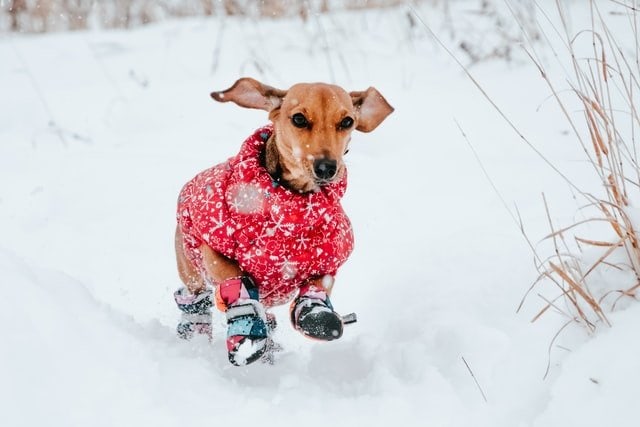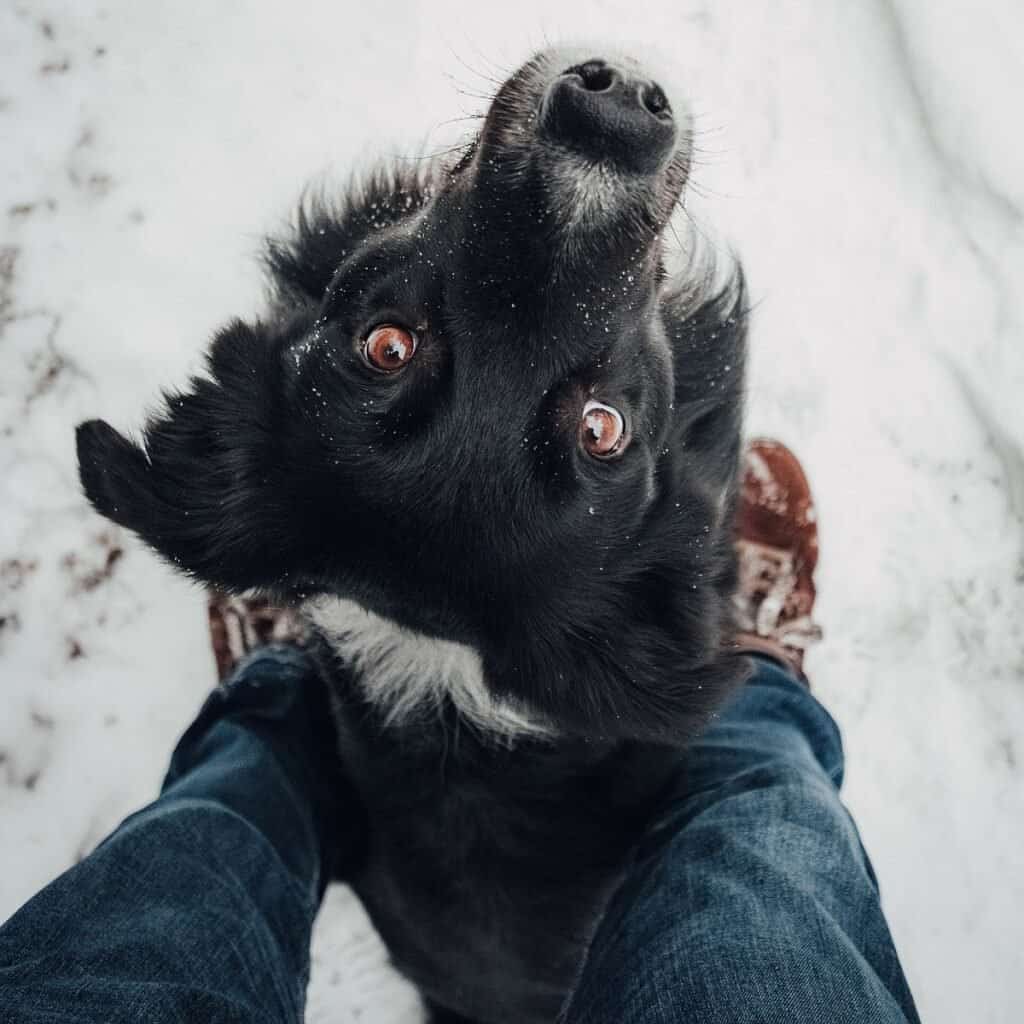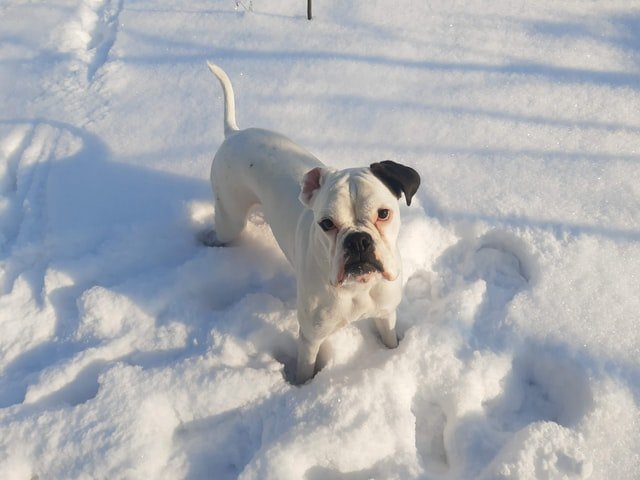When the snow starts to fall, you might start asking yourself if it’s still alright to take your dog for the walks you both love. And if yes, how long can a dog actually walk in the snow?
Some dog parents feel nervous walking their dogs in the snow. The good news is that it’s totally safe as long as you’re taking a few precautions.
Here’s what you need to know on the topic.
Table of Contents
Is it okay for dogs to walk in snow?
Walking your dog is one of the best and easiest ways for him to get some exercise. As an added bonus, it’s a great way for you to get some exercise too!
But there are a lot of things that can affect how pleasant a walk is, and whether or not your dog should be walking in some conditions.
One of the big considerations is, of course, the weather. When it’s too hot out, you run the risk of your dog getting heat stroke.
But what about winter? Walking in the snow comes with its own challenges. While it’s perfectly safe for dogs to walk in the snow in general, you do need to be mindful and cautious of the conditions.
If you’re planning on taking a walk with your dog in the snow, there are a few things you should know.
Does it hurt dogs’ feet to walk in snow?
The snow itself isn’t likely to hurt a dog’s feet when walking. It’s the cold that you have to worry about.
When we humans go for walks in the winter, we make sure to equip ourselves properly. This includes putting on a nice warm coat, a hat, mittens, and of course, boots.
Walking in the snow would be uncomfortable since the snow can be slippery and unstable. The cold can also damage our skin and hurt us.
The same thing is true for your dog!
While dogs do have some fur on the underside of their feet, the paw pads are exposed. Walking on snow or ice could hurt your dog’s unprotected paws, especially if he gets snow or ice stuck between his paw pads. This is why you should consider getting some dog boots before you head out in the cold.
Can dogs walk in snow without shoes?
Buying shoes for your dog can help protect his feet from the snow and the cold. Along with a jacket to keep him warm, shoes will make it much easier for your dog to get around in the snow.
Still, you might be wondering whether or not your dog might be able to walk in the snow without any shoes.
The answer to this question depends largely on what the outside temperature is like. You’ll also need to factor in how much time your dog is spending in the snow.
As long as outside temperatures are above 32–20 degrees Fahrenheit, it’s safe for your dog to play or walk in the snow. However, you won’t want him to be outside for longer than about 30 minutes. If it’s colder, or he’s out longer, you should protect his paws with boots.
Can small dogs walk in snow?
Big dogs have larger legs and might be able to more easily navigate big piles of snow. But what about little dogs?
Could your small dog walk comfortably in the snow?
Small dogs should still be able to walk in the snow while you’re taking the same precautions as you would for a large dog.
That said, there are some additional things to consider. One important thing is your dog’s weight.
Dogs that weigh more have more natural insulation than dogs that weigh less. So if you have a super light dog, then he might need some additional protection like a jacket to keep him warm.
You might also want to make sure you’re spending a little less time in the snow.
How long can a dog walk in snow?
Walking is a fantastic way to get your dog and yourself some exercise. But when it comes to walking in the snow, there are a few additional factors to consider.
If you’re wondering how long you can walk a dog in the snow, this depends on a few things. Before we get into it, make sure you take a look at these related articles about walking dogs in non-snow conditions:
- How Many Walks Should a Dog Have a Day?
- Stop a Dog from Eating Everything on Walks
- How to Tell If Your Dog Is Tired of Walking
Age and health
When deciding whether it’s safe to walk your dog in the snow or how long you should walk him, this is one of the first things to think about.
Your dog’s age will affect a lot of what he’s able to do. Just like us humans, a dog’s body doesn’t work quite as well when he gets older. But that doesn’t mean he can’t do the activities he loves.
It just means you might need to be a little more careful. Old dogs might need to spend less time outside, or have extra gear to keep them warm. The same is true for young puppies whose bodies aren’t fully developed yet.
You should also consider your dog’s overall health. A super active and healthy dog shouldn’t have a problem walking in the snow. But if your dog is in generally poor health, then you might want to avoid spending prolonged periods in the cold.
Watch out for worn paw pads
Most dogs will be completely fine walking in the snow with boots as long as it isn’t too cold or icy.
However, extreme cold can damage your dog’s paw pads directly, and slippery ice can make it difficult for your dog to get any traction as he’s walking.
One thing to be very mindful of is any damage to your dog’s paw pads. You should be attentive to his paws year-round, but you’ll want to be extra careful during the winter.
The most immediate thing you’ll want to make sure of is to prevent your dog from getting frostbite on his paw pads. You should also be mindful about your dog’s paws drying out or chapping because of the snow.
If you live somewhere where they use salt or other chemical de-icers on the sidewalks and roads when it’s icy and snowy, you need to be even more careful of cracked and chapped paws. The salt can get into the cracks and make your dog extremely uncomfortable.
The good news is that you can probably tell if the cold is affecting your dog’s paws. Most dogs will let you know that they’re uncomfortable or in pain.
You might find your dog lifting his legs to try and tell you that his feet are too cold or uncomfortable. Or he may refuse to go further.
If your dog is showing any indication that his feet hurt, it’s time to turn back around. Make sure that you are putting the right equipment on your dog’s feet the next time you head out for a walk.

Stamina and personality
Another major factor that is going to contribute to how your dog handles walking in the snow is who he is as an individual!
While there are a lot of breeds that are better at walking in certain conditions than others, a lot of it just comes down to your specific dog.
You can learn more about adventuring with different breeds by checking out these 18 best dogs for hiking and camping (big and small).
While Labrador Retrievers, for example, are bred to be energetic, every once in a while you’re still going to come across a pretty lazy one. And it might be yours.
Or you might just have a dog that really doesn’t like the way walking in the snow feels!
Your dog’s own stamina can also affect how he’s able to walk. Walking in the snow is more difficult than walking on pavement or on grass. So if your dog tires quickly, he may not be able to go very far in the snow.
Luckily, you can help increase your dog’s stamina with training. This will make walking in the snow easier for him.
How to walk a dog in snow
Now that we’ve covered the basics of whether you can walk your dog in the snow, you might be wondering how to actually walk him successfully in winter.
There are a few simple ways that you can get your dog walking in the snow comfortably and safely.
As always, however, keep an eye on the temperature. Dogs can walk comfortably when it’s below freezing—as long as they have the right equipment. But if it’s so cold outside that even you’re hesitating, it might be best to just stay indoors.
These 21 fun things to do with your dog at home will help you stay busy if it’s too cold.
Most dogs are fine without shoes
Making sure that your dog’s feet are comfortable while walking in the snow is the most important thing for you to do.
That said, most dogs are going to be okay without shoes as long as the temperature isn’t too cold.
Dogs are built to be able to handle most weather without the need of special equipment.
However, you should still be aware that shoes are good to have around for those super chilly or icy days. If it’s below freezing, then you’re going to want to put his shoes on him.
You’re also going to want to think about some added paw protection. The winter and cold can really dry out your dog’s poor feet. There are lots of balms available for your dog’s paw pads, which will keep them safe and comfortable.
Slowly get him used to walking in snow
If your dog isn’t used to walking in the snow yet, then it might be pretty challenging for him at first.
If he’s not taking to it right away, don’t give up. You’ll still be able to walk him in the snow, you’ll just need to get him used to it first.
Start slow and work your way up. That means beginning with shorter, easier walks. You might only be taking him out for five or ten minutes at first, and that’s completely fine.
The more your dog gets used to the snow, the longer you’ll be able to go on your walks.
Related topic: For dog training in general I highly recommend you get a program that walks you through step by step, such as Braintrainingfordogs. Certified dog trainer Adrienne Farricelli teaches you to train your dog to be the best dog he can by be using mental stimulation! Check out Dogpackr’s review to see if this is a fit for you!

Small dogs might need a jacket
Larger dogs should have enough weight to keep them warm in the winter. But if you have a small dog, a jacket to keep him warm is probably a good idea.
Size isn’t the only thing you should consider, however. Some large dogs, even if they are fairly heavy, might need some extra help to stay warm.
Boxers, for instance, tend to have pretty short coats. That means that the cold is more likely to affect them than a dog with a longer coat. If you have a breed like this whose coat is rather short, then a jacket might be necessary.
If his paw pads get worn easily, get him some snow boots
All dog parents should be mindful of their dogs’ paws when walking. But some dogs’ paw pads get worn much faster than others’.
Always keep an eye on your dog’s feet to make sure that he isn’t injuring himself. If your dog doesn’t want to walk any further because his feet are bothering him, don’t force him to keep going.
Instead, return home and invest in some snow boots for your dog. The boots should help your dog navigate the snow much more easily, and keep his feet nice and warm. They’ll also prevent your dog’s feet from chapping or cracking from the cold.
Conclusion
Many dog owners wonder if it’s safe to walk their dogs in the snow. By taking the proper precautions, you and your dog will be able to walk with no issues even when it’s super snowy outside. Just remember to keep the above tips in mind, and to make walking in the snow fun for your dog!
*Disclosure: This post may contain affiliate links, meaning, I get a commission if you decide to make a purchase through one of my links, at no cost to you.




